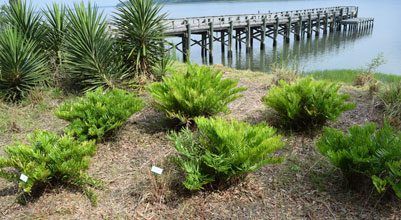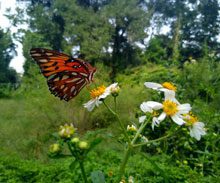 What a great blessing! I am able to celebrate both the unmatched offerings of nature surrounding me on all sides as well as the joys and challenges of trying to make a garden. To be sure, the close presence of nature does make some aspects of gardening more challenging than I would like.
What a great blessing! I am able to celebrate both the unmatched offerings of nature surrounding me on all sides as well as the joys and challenges of trying to make a garden. To be sure, the close presence of nature does make some aspects of gardening more challenging than I would like.
Take the deer – please! Whereas I often find their tracks close by, in both the garden on the creek and at the farmstead, usually I don’t find their damage too significant. Most years they will confine themselves to nibbling one or two plants which appeared along their path that day. Usually, the plants will recover fairly quickly and in good health. Even if I lose a few plants one year, I usually figure there are plenty more left untouched; and there is plenty of excellent fodder out in the woods adjacent to the gardens to attract them before they get to the garden. So usually, we sort of live by an unspoken agreement not to do any major harm to each other.
This year, though, I foolishly placed a couple of potted hydrangeas by the driveway, which runs through the woods at the property on the creek. These were my beloved Ayesha hydrangeas, grown large and handsome and just coming into bloom. There were some smaller ones, also in pots, placed nearby – General Foch, Painter’s Palette, and Lady In Red – which had just started to form their bloom-heads, too.
The first to be attacked were the large Ayeshas; the deer simply sheered off the ends of every flowering stem about two feet down. I’m sure it was delicious. I knew, of course, that the plants themselves were not harmed; in fact they’d grow back even bushier and fuller. But I’m going to miss all those gorgeous lilac-like blooms this year.
Within the week the others had similarly been gnawed down to stubs. Smaller plants by nature, the loss of substantial new growth could significantly stunt their ability to regrow vigorously. So all these treasures were summarily removed and taken up to the farmhouse garden. We’ll see if we can find suitable places for them, but I just noticed that the new planting bed – the one I’m creating beneath the old Kieffer pears and the giant Camellia sasanqua – revealed a cloven hoof print in the soil the other morning. No damage from deer in that bed yet, thankfully; but it is a reminder to be cautious in plant placement and selection.
Far more of a nuisance than deer in the farmhouse garden are the squirrels. Actually, we have two distinct types of squirrels, the ubiquitous grey squirrel (Sciurus carolinensis) which everyone is familiar with; and the fox squirrel (Sciurus niger) which far fewer people seem to have encountered. The fox squirrel is a large ground squirrel, two or three times the size of the grey squirrel, and they appear in blacks, whites, greys, browns, solids, spots, and patches. There’s one pair here at the farm which has a charcoal-black male and a pale grey female. She has a black mask on her face; he has two white spots, one on the tip of each ear. I find them delightful to watch and they interfere rarely with my gardening or with keeping house.
Grey squirrels, on the other hand, daily turn over dozens of my potted plants. Those they don’t turn over they dig up; whatever is planted they throw out to see if they have buried a nut in the soil beneath the plant. Sometimes they bury a nut there and never go back for it, and a year later I discover I have a large pecan seedling growing in a pot of Dancing Ladies Ginger (Globba winitii).
I just discovered last week that my father’s apple tree, which hadn’t managed to set a single fruit this year because of bad timing for its blooming and a late frost, did in fact have one branch of apples so high in the tree as to be nearly impossible to get. Gorgeous big green apples, which would eventually ripen to a rich red. Because there were only a dozen or so, I was watching them closely. And for three days last week I watched as, one by one, each apple was nibbled by a squirrel, found to be unripe (duh!), and thrown to the ground. By the third day, every single apple had been thrown to the ground. This is the tree that I recently described as needing to be removed, as it is beneath the power line and reaching toward it. Consider it gone, squirrels.
The armadillos, too, have lately become a nuisance. They tend to choose locations under a porch or adjacent to the foundation to dig their big tunnels with mounds of dirt piled at the entrance. That is, they dig next to the house when they’ve tired of digging a tunnel at the base of a tree or beneath one of the large heavy containers in the garden. Holes which I’ve inadvertently stepped into and nearly broken a leg.
I learned from Master Gardener extraordinaire Sandra Educate on Making It Grow that the master gardeners are testing a new repellent for deer. The exciting thing is that it is systemic – it gets into the vascular system of the plant from tablets in the ground at the root. The active repellent is capsaicin, the “burn” in hot peppers, and deer apparently don’t like it. I’ve learned that some forms use DMSO to carry the capsaicin into the plant tissues, and because of this, I would be very hesitant to use it on any plants for human consumption – and, indeed, the brand Repellex is not approved for use on food crops. The manufacturer does claim, however, that it can be effective in repelling “deer, rabbits, moles, voles, gophers, groundhogs, dogs, cats and feral hogs.”
Terrifying depredations notwithstanding and damage to beloved garden plants’ tender parts rampant– not to mention areas of lawn and planting beds booby-trapped with holes – for the most part, attempting to prevent these incursions in the yard and garden is ultimately futile. Gradually I’m learning that some things I can do can reduce the damage, if not prevent it; learning to distract the wildlife from doing too much harm often aids in keeping some things safe. And when nothing works, then I need to consider whether that plant really needs to be in my garden.
It pleases me enormously to share these spaces with nature, to be allowed to witness and participate in the always-changing life that the natural world is. Except maybe the squirrels . . . and the armadillos . . . and the deer. But my gardens and I know how to rejoice when a passing automobile removes one of those possums-on-the-half-shell from the population, or when nature takes its course and our resident red-tailed hawk swoops from on high and snatches one of those infuriating grey rodents. Even the red-tailed hawk knows how to celebrate nature then.
Will Balk, Jr. is an occasional contributor to the online journal Weekly Hubris







